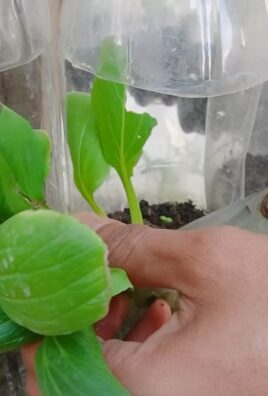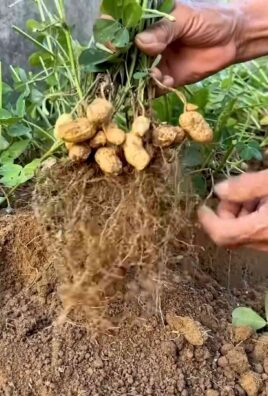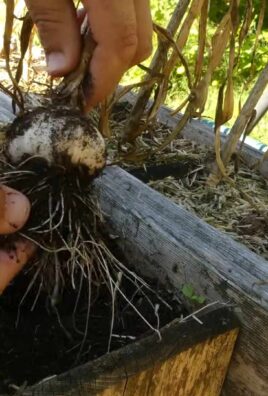Grow Fennel at Home, and unlock a world of culinary possibilities right in your backyard! Have you ever dreamed of snipping fresh, fragrant fennel fronds to elevate your dishes or harvesting plump bulbs for a crisp, anise-flavored treat? Well, dream no more! This guide is your passport to successfully cultivating this versatile herb and vegetable, even if you’re a complete beginner.
Fennel has a rich history, dating back to ancient civilizations. The Romans prized it for its medicinal properties and culinary uses, believing it promoted longevity and strength. In some cultures, it was even thought to ward off evil spirits! Today, fennel continues to be a beloved ingredient in cuisines around the world.
But why should you bother to grow fennel at home? Simple! Store-bought fennel often lacks the vibrant flavor and freshness of homegrown varieties. Plus, growing your own allows you to control the growing conditions, ensuring you have access to organic, pesticide-free fennel whenever you need it. Imagine adding freshly harvested fennel to your salads, soups, or grilled dishes – the difference in taste is truly remarkable. I’m excited to share my favorite tips and tricks for successfully growing fennel, so let’s get started!

Growing Fennel at Home: A Beginner’s Guide
Hey there, fellow gardening enthusiasts! Ever thought about growing your own fennel? It’s surprisingly easy and rewarding. Not only does it add a unique flavor to your dishes, but it also looks beautiful in the garden. I’m going to walk you through everything you need to know to successfully grow fennel at home, from seed to harvest. Let’s get started!
Choosing Your Fennel Variety
Before we dive into the nitty-gritty, let’s talk about fennel varieties. There are two main types: bulb fennel (also known as Florence fennel) and herb fennel.
* **Bulb Fennel:** This is the one you’ll find in the grocery store with the swollen, bulbous base. It’s fantastic for roasting, grilling, or adding raw to salads.
* **Herb Fennel:** This type is grown primarily for its feathery leaves and seeds. The bulb is much smaller and less desirable.
For this guide, I’ll focus on growing bulb fennel, but the general principles apply to both. Some popular bulb fennel varieties include ‘Romanesco’, ‘Perfection’, and ‘Zefa Fino’.
Getting Started: Planting Fennel
Fennel can be a bit finicky about transplanting, so I highly recommend direct sowing the seeds into your garden. Here’s how:
1. **Timing is Key:** Fennel thrives in cooler weather. For a spring crop, sow seeds 2-3 weeks before the last expected frost. For a fall crop, sow seeds in late summer, about 8-10 weeks before the first expected frost. I usually aim for late August for my fall crop.
2. **Choosing the Right Location:** Fennel needs at least 6-8 hours of sunlight per day. Make sure you pick a spot in your garden that gets plenty of sunshine. Also, ensure the soil is well-draining.
3. **Preparing the Soil:** Fennel prefers rich, well-drained soil with a pH between 6.0 and 7.0. Before planting, amend the soil with compost or well-rotted manure. This will provide the necessary nutrients and improve drainage. I like to add a generous amount of compost – about 2-3 inches worked into the top 6-8 inches of soil.
4. **Sowing the Seeds:** Sow the seeds about ½ inch deep and 2-3 inches apart. Gently cover them with soil and water thoroughly.
5. **Thinning Seedlings:** Once the seedlings emerge (usually in 7-14 days), thin them to about 8-12 inches apart. This will give the plants enough room to grow and develop their bulbs. Don’t just pull them out! I carefully snip the unwanted seedlings at the soil line with small scissors to avoid disturbing the roots of the remaining plants.
Caring for Your Fennel Plants
Once your fennel seedlings are established, it’s time to focus on providing them with the care they need to thrive.
1. **Watering:** Fennel needs consistent moisture, especially during hot, dry weather. Water deeply whenever the top inch of soil feels dry. Avoid overhead watering, as this can lead to fungal diseases. I prefer using a soaker hose or drip irrigation to deliver water directly to the roots.
2. **Weeding:** Keep the area around your fennel plants free of weeds. Weeds compete for nutrients and water, which can stunt the growth of your fennel. I like to hand-weed regularly and apply a layer of mulch to suppress weed growth.
3. **Fertilizing:** Fennel is a heavy feeder, so it benefits from regular fertilization. Apply a balanced fertilizer (e.g., 10-10-10) every 4-6 weeks. You can also side-dress with compost or well-rotted manure. I usually use a liquid seaweed fertilizer diluted according to the package instructions.
4. **Blanching (Optional):** To get a whiter, more tender bulb, you can blanch your fennel plants. About 2-3 weeks before harvest, mound soil around the base of the bulb, covering it up to the lower leaves. This will block sunlight and prevent the bulb from turning green.
5. **Pest and Disease Control:** Fennel is generally pest-resistant, but it can be susceptible to aphids, slugs, and snails. Check your plants regularly for signs of infestation and take action promptly. For aphids, I use a strong spray of water or insecticidal soap. For slugs and snails, I use beer traps or diatomaceous earth. Regarding diseases, root rot can be a problem in poorly drained soil. Make sure your soil is well-draining and avoid overwatering.
Harvesting Your Fennel
The moment we’ve all been waiting for! Harvesting your homegrown fennel.
1. **When to Harvest:** You can harvest fennel bulbs when they reach about 3-4 inches in diameter. This usually takes about 80-100 days from sowing. Don’t wait too long, or the bulb may become tough and fibrous.
2. **How to Harvest:** To harvest the bulb, use a sharp knife to cut it off at the base of the plant, just above the soil line. You can also harvest the leaves and stalks as needed. The leaves can be used fresh or dried for later use.
3. **Storing Fennel:** Fresh fennel bulbs can be stored in the refrigerator for up to a week. Wrap them loosely in plastic wrap or store them in a plastic bag. The leaves can be stored in the refrigerator for a few days, wrapped in a damp paper towel.
Using Your Homegrown Fennel
Now that you’ve harvested your fennel, it’s time to enjoy the fruits (or rather, vegetables) of your labor!
* **Bulb Fennel:** The bulb can be eaten raw in salads, roasted, grilled, or sautéed. It has a mild, anise-like flavor that pairs well with seafood, chicken, and vegetables. I love roasting fennel with olive oil, salt, and pepper until it’s tender and caramelized.
* **Fennel Leaves:** The leaves can be used as a garnish, added to salads, or used to flavor soups and stews. They have a more intense anise flavor than the bulb. I often chop them up and add them to my homemade pesto.
* **Fennel Seeds:** The seeds can be used as a spice in a variety of dishes. They have a warm, licorice-like flavor that’s great in sausages, breads, and sauces. I like to toast them lightly before grinding them to release their flavor.
Troubleshooting Common Fennel Problems
Even with the best care, you might encounter some problems while growing fennel. Here are a few common issues and how to address them:
* **Bolting:** Bolting is when the plant prematurely flowers and goes to seed. This can happen if the weather gets too hot or if the plant is stressed. To prevent bolting, choose a bolt-resistant variety, provide consistent moisture, and protect the plants from extreme heat.
* **Bulb Splitting:** Bulb splitting can occur if the plant experiences inconsistent watering. To prevent splitting, water regularly and deeply, especially during dry periods.
* **Aphids:** Aphids are small, sap-sucking insects that can weaken your fennel plants. To control aphids, spray them with a strong stream of water or insecticidal soap.
* **Slugs and Snails:** Slugs and snails can damage fennel leaves and bulbs. To control them, use beer traps or diatomaceous earth.
Fennel’s Companion Plants
Companion planting is a great way to improve the health and productivity of your garden. Some good companion plants for fennel include:
* **Dill:** Dill attracts beneficial insects that prey on aphids.
* **Chamomile:** Chamomile attracts beneficial insects and can help improve the flavor of fennel.
* **Marigolds:** Marigolds repel nematodes and other pests.
However, fennel can inhibit the growth of some plants, so avoid planting it near:
* **Tomatoes:** Fennel can inhibit the growth of tomatoes.
* **Beans:** Fennel can inhibit the growth of beans.
* **Kohlrabi:** Fennel can inhibit the growth of kohlrabi.
Saving Fennel Seeds
If you want to save seeds from your fennel plants, allow a few plants to flower and go to seed. Once the seed heads are dry and brown, cut them off and hang them upside down in a paper bag to dry completely. Once the seeds are dry, separate them from the seed heads and store them in an airtight container in a cool, dry place.
Final Thoughts
Growing fennel at home is a rewarding experience that allows you to enjoy fresh, flavorful produce right from your garden. With a little bit of care and attention, you can successfully grow fennel and add a unique touch to your culinary creations. Happy gardening!

Conclusion
So, there you have it! Growing fennel at home isn’t just a gardening project; it’s an invitation to a world of fresh, aromatic flavors and a deeper connection with your food. We’ve walked you through the simple steps, from selecting the right variety to nurturing your plant and harvesting its bounty. But why should you take the plunge and dedicate a little space in your garden or even a sunny windowsill to this delightful herb?
The answer is multifaceted. First and foremost, the taste of homegrown fennel is simply unparalleled. Forget the sometimes-wilted, often-expensive bulbs you find at the grocery store. Imagine the crisp, anise-like flavor of freshly harvested fennel fronds brightening your salads, the subtly sweet crunch of the bulb adding depth to your roasted vegetables, and the aromatic seeds infusing your homemade sausages or breads with a unique character. This is the power of fresh, homegrown ingredients.
Beyond the superior flavor, growing your own fennel offers a sustainable and cost-effective way to enjoy this versatile herb. You’ll reduce your reliance on commercially grown produce, minimize your carbon footprint, and save money in the long run. Plus, the act of gardening itself is incredibly therapeutic, providing a welcome respite from the stresses of daily life.
But the benefits don’t stop there. Growing fennel at home also allows you to experiment with different varieties and preparations. Try growing Florence fennel for its bulb, or common fennel for its seeds and fronds. Once you’ve harvested your fennel, explore the endless culinary possibilities. Roast the bulb with olive oil and herbs, add the fronds to salads or soups, or use the seeds to season your favorite dishes. You can even pickle the bulb for a tangy and refreshing treat.
For those who are feeling adventurous, consider these variations:
* **Fennel Pollen Infusion:** Harvest the pollen from your fennel flowers and infuse it into olive oil for a truly unique and flavorful condiment.
* **Fennel Tea:** Steep the dried fennel seeds in hot water for a soothing and digestive-friendly tea.
* **Companion Planting:** Plant fennel alongside other vegetables like tomatoes and cucumbers to attract beneficial insects and deter pests. Be mindful, however, that fennel can inhibit the growth of some plants, so research companion planting carefully.
Ultimately, growing fennel at home is a rewarding experience that offers a multitude of benefits, from superior flavor and sustainability to therapeutic gardening and culinary experimentation. It’s a chance to connect with nature, nourish your body, and elevate your cooking to new heights.
We wholeheartedly encourage you to give it a try. Don’t be intimidated if you’re a beginner gardener. Fennel is a relatively easy plant to grow, and the rewards are well worth the effort. So, grab some seeds or a seedling, find a sunny spot, and get ready to embark on your fennel-growing adventure.
And most importantly, we want to hear about your experience! Share your tips, tricks, and culinary creations with us in the comments below. Let’s build a community of fennel enthusiasts and inspire others to discover the joys of growing their own food. Happy gardening!
Frequently Asked Questions (FAQs)
What is the best time of year to plant fennel?
The best time to plant fennel depends on your climate. In warmer climates, you can plant fennel in the spring or fall. In cooler climates, it’s best to plant fennel in the spring after the last frost. Fennel prefers cooler weather, so avoid planting it during the hottest months of summer. If you are growing fennel for the bulb, spring planting is ideal as high summer heat can cause bolting (premature flowering).
How much sunlight does fennel need?
Fennel needs at least 6 hours of sunlight per day to thrive. Choose a location in your garden that receives full sun for optimal growth. If you’re growing fennel indoors, place it near a sunny window or use a grow light. Insufficient sunlight can lead to leggy growth and reduced bulb size.
What kind of soil does fennel prefer?
Fennel prefers well-drained soil that is rich in organic matter. Amend your soil with compost or other organic materials before planting to improve drainage and fertility. A slightly acidic to neutral soil pH (around 6.0 to 7.0) is ideal. Avoid heavy clay soils, as they can retain too much moisture and lead to root rot.
How often should I water fennel?
Water fennel regularly, especially during dry periods. Keep the soil consistently moist, but avoid overwatering, which can lead to root rot. Water deeply when the top inch of soil feels dry to the touch. Mulching around the base of the plant can help retain moisture and suppress weeds.
How do I harvest fennel?
The harvesting method depends on what part of the fennel you want to use. For the bulb, harvest when it reaches a desired size, typically around 2-3 inches in diameter. Gently loosen the soil around the bulb and pull it up. For the fronds, you can harvest them at any time as needed. Simply snip off the fronds with scissors or pruning shears. For the seeds, allow the flower heads to dry completely on the plant. Then, cut off the flower heads and place them in a paper bag. Shake the bag to release the seeds.
Why is my fennel bolting (flowering prematurely)?
Bolting in fennel is often caused by stress, such as high temperatures, drought, or poor soil conditions. To prevent bolting, choose a bolt-resistant variety, plant fennel in the spring or fall, provide adequate water, and amend your soil with organic matter. If your fennel does bolt, you can still harvest the fronds and seeds, but the bulb may become tough and less flavorful.
Can I grow fennel in a container?
Yes, you can grow fennel in a container, but choose a large container (at least 12 inches in diameter) to accommodate the plant’s root system. Use a well-draining potting mix and provide adequate sunlight and water. Container-grown fennel may require more frequent watering and fertilization than fennel grown in the ground.
Is fennel a perennial or an annual?
Fennel is technically a short-lived perennial in warmer climates (zones 7-10), meaning it can live for more than two years. However, it is often grown as an annual, especially in colder climates, because it may not survive harsh winters. If you live in a colder climate, you can try to overwinter your fennel plant by mulching heavily around the base of the plant or bringing it indoors.
Does fennel attract any beneficial insects?
Yes, fennel is a great plant to attract beneficial insects to your garden, such as ladybugs, lacewings, and hoverflies. These insects prey on common garden pests like aphids and whiteflies, helping to keep your garden healthy and pest-free.
Can I eat the fennel flowers?
Yes, fennel flowers are edible and have a mild anise flavor. You can use them as a garnish for salads, soups, and other dishes. You can also use them to make fennel pollen, which is a highly prized spice.
How do I store fennel?
Store fennel bulbs in the refrigerator for up to a week. Wrap them in a damp paper towel and place them in a plastic bag. Store fennel fronds in the refrigerator in a glass of water, like you would with fresh herbs. Store fennel seeds in an airtight container in a cool, dark place.




Leave a Comment